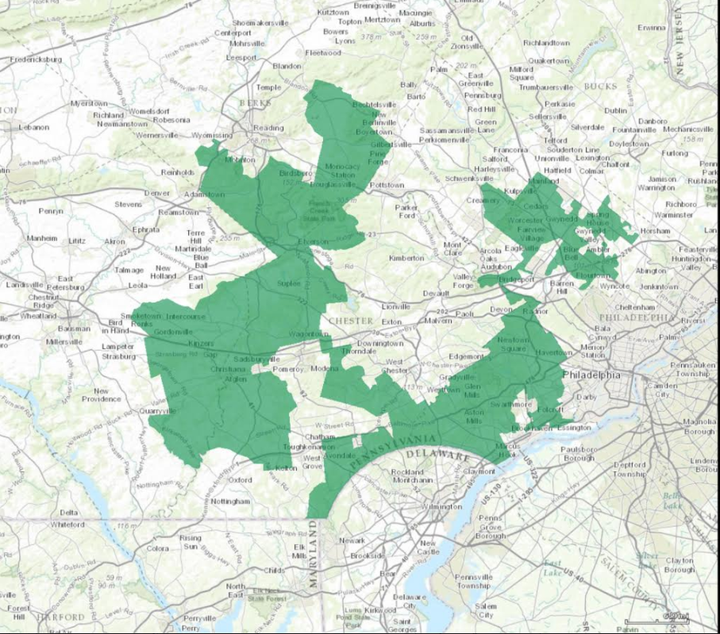In Pennsylvania, there is Goofy kicking Donald Duck. In Maryland, a “broken-winged pterodactyl.” In Illinois, there are earmuffs.
To the naked eye, these districts are the smoking gun of gerrymandering. But experts say that while an unusual outline can indicate something is amiss, evaluating the unfairness of a gerrymander runs much deeper than looking at shape.
The complexity of diagnosing a gerrymander is currently on display in Pennsylvania, where top Republicans released a proposed fix for the state’s congressional map on Friday.
In January, the Pennsylvania Supreme Court found that the state’s congressional map “clearly, plainly and palpably” violated the state’s constitution, and the plan put forth on Friday contained districts that looked a little tidier.
Goofy kicking Donald Duck was gone, but analysis of the new plan shows that the redrawn districts would benefit Republicans. Brian Amos, a redistricting expert at the University of Florida, found in his analysis that President Donald Trump would beat Hillary Clinton in 12 of the state’s 18 electoral districts ― the same results that would have happened under the old plan. Under the map currently in place, Republicans control 13 of the state’s 18 congressional seats, despite winning about 50 percent of the statewide vote. There are more than 800,000 more registered Democrats in the state than Republicans.

Pennsylvania Gov. Tom Wolf (D) rejected the Republican proposal on Tuesday, saying it still amounted to an unfair gerrymander that benefited Republicans. Now, the state Supreme Court is likely to draw a fairer map. What those maps will look like is still to be determined.
To be sure, some lines will zig and zag in order to preserve certain communities. The important question is not what the districts look like, but whether there is a legitimate reason they look like that.
Keith Gaddie, a political science professor at the University of Oklahoma who helped Wisconsin Republicans draw the state’s legislative map in 2011, said trying to determine a gerrymander using shape alone was like trying to diagnose cancer just by looking at one’s skin.
“It can be a melanoma, [or] you could just have an ugly mole,” he said in an interview with HuffPost.
Justin Levitt, a professor at Loyola Law School in Los Angeles who closely follows redistricting issues, criticized efforts to name misshapen districts after strange creatures. He says communities just aren’t organized in neat, geometrical shapes. When you superimpose districts on a Google Map, Levitt says, you can sometimes see that they’re drawn to follow highways, rivers and other barriers that provide a rationale for why districts look really weird.
“You shouldn’t only look to squiggly districts as the bad ones,” Levitt told HuffPost. “You should look below some of the good-looking ones too. And you should dig a little bit deeper into the squiggly ones to see if they’re actually bad.”
To Levitt, one has to look beyond shape and to lawmakers’ rationale in order to assess a gerrymander. Advances in technology and statistical modeling now provide a powerful set of tools that can be used to study electoral districts.
In Pennsylvania, for example, an expert for those challenging the congressional map used computer software to randomly draw hundreds of maps that were more fair than the one Republicans put in place. The analysis offered concrete evidence that Republicans were concerned with partisan advantage over other factors when they drew the state’s congressional map.
“If you can explain why Goofy is kicking Donald Duck, and if that’s a real community with real profound distinct representational interests, maybe it doesn’t matter that Goofy is kicking Donald Duck,” Levitt said. “And if you can’t, maybe that indicates that there’s something more nefarious in mind.”
During oral argument at the Supreme Court, lawyers for Pennsylvania Republicans didn’t attempt to offer an explanation for their congressional map other than partisan intent. In North Carolina, a Republican in charge of the redistricting process openly admitted that the reason they drew the map to give Republicans a 10-3 advantage in Congress was because it was not possible to draw a map that gave Republicans more seats.
While partisanship underlies some of the country’s most oddly shaped districts, there is a reasonable explanation for why a district has a weird shape.
In Illinois, Republicans have pointed to the earmuff-shaped 4th congressional district as an example of an egregious gerrymander drawn to preserve Democratic representation.

The Voting Rights Act prohibits lawmakers from drawing lines that dilutes the influence of minority voters, and the 4th congressional district is drawn that way to preserve the influence of Latino voters, said Michael McDonald, a redistricting expert and professor at the University of Florida.
The district looks like earmuffs because Latino voters live in two pockets separated by a largely African-American community, McDonald said. The odd earmuff shape ensures that the African-American voters don’t dilute the influence of Latino voters and vice versa.
“The question that was faced back in 1992, when the district was first created, was, ‘How do you simultaneously give representation to African Americans and to Latinos?’ You can’t do it by just drawing a district that would be in compact form. You couldn’t do that. That would cut through the African-American community,” McDonald said.
The unusual shape of the district appears to have its intended effect. In 1992, the voters in Illinois’ 4th district elected Luis Gutierrez to represent them, making him the first elected Hispanic member of Congress from the midwest.
The way we draw districts is about something much deeper than shape, Levitt said. It’s about how Americans can expect their elected representatives to advance their interests.
“When you only look to shape, I think you’re losing why we lose representation in the first place,” he said. “When you have a representative who’s in a legislature and they represent the tech industry, or the farm industry, or the north side of town or the south Side of town, then you can hold your representative accountable because you know what they’re supposed to be doing.”
Lacking a common interest can increase partisanship, Levitt says, because people begin to fall back on party affiliation as they only way to gauge whether or not their representative is doing a good job.
“When you don’t have a representative with clear communities behind them, it is much easier for them to fall back on rough proxies of Democrats or Republicans in order to figure out whether we like what they’re doing or not,” he said.

